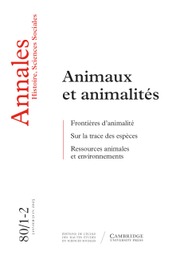Article contents
L'homme et la destruction des ressources naturelles : la Raubwirtschaft au tournant du siècle*
Published online by Cambridge University Press: 26 July 2017
Extract
La deuxième moitié du siècle dernier a vu fleurir une profusion d'idéologies en Occident. C'est l'époque de la formation de l'État moderne, de la montée du nationalisme, de la percée du capitalisme industriel, de l'urbanisation rapide, du colonialisme, de la formation d'une économie mondiale et de conflits sociaux aigus. Des idéologies scientifiques, comme l'évolutionnisme, le positivisme ou divers matérialismes se répandent dans le sillage des découvertes des sciences naturelles, théories de l'évolution de Darwin ou lois fondamentales de la thermodynamique. Un certain messianisme progressiste est dans l'air.
Summary
In its formative period, geography defined itself as the science that studied the interaction between man and his environment. This article looks at the question of how early-twentieth-century geographers dealt with the negative side of this interaction, i.e. Raubwirtschaft (destructive economy). The few geographers to tackle the issue made virtually no attempt to theorize the destructive agency of man. Neither political economy, with its focus on man's development of nature, nor the emerging discipline of ecology, defined as the study of organisms’ adaptation to their environment, was able to provide appropriate tools for geographers. Some scholars, such as Bernard Brunhes, tried to transcend the characteristic anthropocentrism of Western science and geography by drawing parallels between Raubwirtschaft and entropic processes in the biosphere. Destructive economy, it is argued here, was one of the most original issues for geographers to investigate. Instead of doing so, and developing and identity of their own, geographers have preferred to imitate other sciences. This has led to a continuous crisis in geographical thought.
- Type
- Intersciences
- Information
- Copyright
- Copyright © École des Hautes Études en Sciences Sociales, Paris, 1984
Footnotes
Cette étude est une version révisée et mise à jour d'une communication faite au colloque « Idéologie et géographie/Geography and Ideology », Cambridge, 23-25 mars 1979, miméo, 21 p. sans bibliographie, imprimée dans la collection de mes études et essais des années soixante-dix « Maailman ymmärtämisen mahdollisuuksista » (Sur les possibilités de comprendre le monde), Paradoksi III, Helsinki, 1980, pp. 371-386. J'ai publié une étude sur le thème voisin en finnois Kehityksen entropologia ja entropologian kehitys. Lànsimainen tiède tuhon ongelman ääressä tämän vuosisadan alussa (Le développement de l'anthropologie et l'anthropologie du développement. Les sciences occidentales face au problème de destruction au début de ce siècle) dans l'ouvrage collectif édité par Ilmo MASSA, Energia, kulttuurija tulevaisuus (Énergie, civilisation et avenir), Helsinki, 1982, pp. 15-60, en essayant d'esquisser les fondements d'une anthropologie.
Je remercie M. Paul Claval pour son aide dans la rédaction de cette étude. Je remercie également M. Clemens Heller et la Maison des Sciences de l'Homme pour le soutien financier qui m'a été accordé.
References
Bibliographie
- 23
- Cited by


